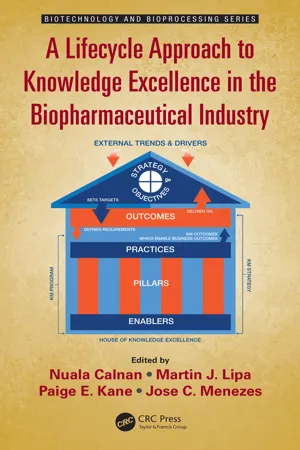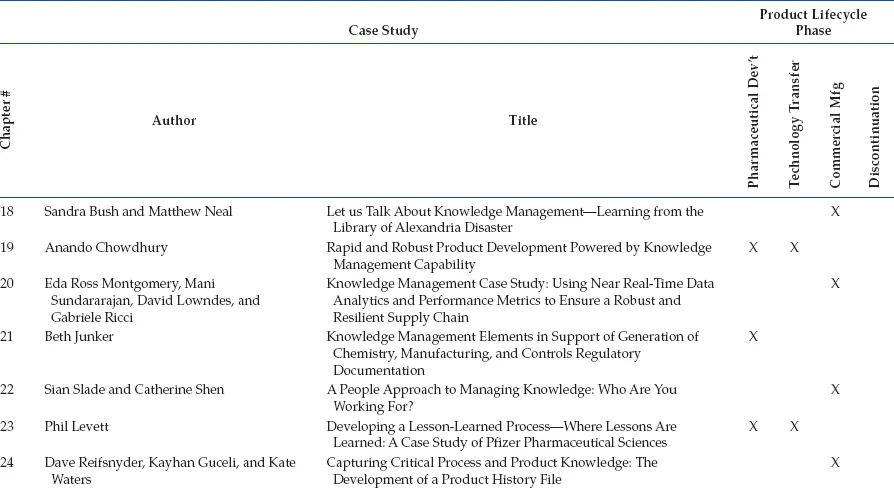
eBook - ePub
A Lifecycle Approach to Knowledge Excellence in the Biopharmaceutical Industry
This is a test
- 523 pages
- English
- ePUB (mobile friendly)
- Available on iOS & Android
eBook - ePub
A Lifecycle Approach to Knowledge Excellence in the Biopharmaceutical Industry
Book details
Book preview
Table of contents
Citations
About This Book
This book addresses the rapidly emerging field of Knowledge Management in the pharmaceutical, medical devices and medical diagnostics industries. In particular, it explores the role that Knowledge Management can play in ensuring the delivery of safe and effective products to patients. The book also provides good practice examples of how the effective use of an organisation's knowledge assets can provide a path towards business excellence.
Frequently asked questions
At the moment all of our mobile-responsive ePub books are available to download via the app. Most of our PDFs are also available to download and we're working on making the final remaining ones downloadable now. Learn more here.
Both plans give you full access to the library and all of Perlego’s features. The only differences are the price and subscription period: With the annual plan you’ll save around 30% compared to 12 months on the monthly plan.
We are an online textbook subscription service, where you can get access to an entire online library for less than the price of a single book per month. With over 1 million books across 1000+ topics, we’ve got you covered! Learn more here.
Look out for the read-aloud symbol on your next book to see if you can listen to it. The read-aloud tool reads text aloud for you, highlighting the text as it is being read. You can pause it, speed it up and slow it down. Learn more here.
Yes, you can access A Lifecycle Approach to Knowledge Excellence in the Biopharmaceutical Industry by Nuala Calnan, Martin J Lipa, Paige E. Kane, Jose C. Menezes in PDF and/or ePUB format, as well as other popular books in Medizin & Pharmakologie. We have over one million books available in our catalogue for you to explore.
Information
Section IV
Practices and Case Studies in Enabling Knowledge Flow
This section contains a collection of case studies from across the biopharmaceutical industry which profiles a variety of current knowledge management (KM) efforts. Some of the stories shared are broad and far-reaching KM programs, whereas others are localized. Some are sponsored by various functional leaders, whereas some are grassroots initiatives. To aid review, each of these efforts has been coarsely categorized by the editors to the product lifecycle phase in which it is focused (per ICH Q10). Furthermore, each case study has also been mapped to indicate which specific practices have played a role. The following matrix and associated mapping should prove to be a useful reference guide for KM practitioners to see how various companies have approached KM.
It is however important to note that the case studies that follow are not necessarily a how to for a given product lifecycle phase or practice. Rather, these case studies represent real and tangible KM efforts, often in the context of a business problem, that show how the author and their company leveraged knowledge management to address a specific business problem. These studies also serve to highlight various organizational drivers for KM, definitions of KM, and targeted outcomes.
These case studies do not necessarily represent the entirety of a firm’s KM efforts, nor what functions or lifecycle phases they focus on, nor where in the lifecycle they focus. These are included as real-life examples to illustrate and teach. Finally, keep in mind that not all language and descriptors used in the case studies may be consistent with how the editors have described practices, pillars, and enablers in Section III.
TABLE 1
Mapping of Case Studies to Product Lifecycle Phase


Note: X indicates an area of focus.
TABLE 2
Mapping of Case Studies to KM Practices



Note: “+” indicates degree relevance (none, + low, ++ high).
18
Let’s Talk about Knowledge Management—Learning from the Library of Alexandria Disaster
CONTENTS
What Does an Effective Learning Organization Look like?
What Does a Good Knowledge Management Capability Look like?
How Do You Start from Zero?
The MarketPlace
The Customers
The Products
Negative Events Are Learning Opportunities
Lifecycle
Focusing on in the Flow Delivery of Knowledge
Social Media for Business
One-Point Lessons
Content Repositories, Taxonomies, and Search
Global Networks
Alerts
So What Did We Learn?
We Are Never Going Back
References
History is meant to teach, yet how should organizations enable themselves to be ready to learn from their past experiences? This case study challenges the preconceptions around the value of social media and other societal norms of how we share and use what is currently known by the complex collection of individual contributors within a corporation. It discusses how these individual contributions can be harnessed to establish a collective corporate memory by outlining the key elements of an effective learning organization are.
Editorial Team
Yes, the Library of Alexandria (El-Abbadi 2016) (we’ll get to this). But first…
The typical approach to knowledge management in the pharmaceutical industry is focused on a regulatory view, big data, or product lifecycle management as outlined in ICH Q10 Pharmaceutical Quality System (ICH Harmonised Tripartite Guideline, 2008). This is a valuable way to think about knowledge management, but lacks the important detail that work is done through and with people. Knowledge is exchanged through and with people. To that end, it was important to Global Manufacturing Operations within a large biotech to focus knowledge management efforts on the exchange of experiential information to build organizational knowledge and improve the overall operation.
The highly regulated nature of the pharmaceutical industry ensures development of robust processes that mandate content is maintained, transferred, and accessible with a focus on regulatory compliance, while turning much less focus on learning in the organization. In this context, learning is not training. Any pharmaceutical company has highly trained staff, but how are companies sharing their experiences and learning as an organization to ensure mistakes are not repeated? How can we protect that knowledge and embed it in the way we operate so we do not lose the knowledge?
Our journey into the development of a knowledge management capability began with a simple question: How can we avoid repeating the same mistakes? To go one step further, how can knowledge management enable an effective learning organization? Through external research and benchmarking outside of the pharmaceutical industry, we defined an effective learning organization by the following characteristics. It is through these characteristics that an organization can fully leverage the knowledge it gains from experiences to improve its performance. We will explore each of the following characteristic in further detail:
• Thinks systematically and solves problems with analytical thinking
• Learns from its successes and failures and from those of others
• Takes initiative to capture and share knowledge
• A willingness to change based on experience
• Leaders are teachers and improve their teams through coaching
• Commitment to personal mastery (Senge 1990)
It seems intuitive that an organization would find it valuable to be an effective learning organization (ELO), but it would seem, that unless they can rally that desire around a specific problem, they will not achieve ELO performance. ELOs benefit from reduced error rates, have integrated their experiences into their processes, and spend less time relearning from mistakes. We determined that they did not have an effective knowledge management infrastructure. This was evidenced by a lack of high quality knowledge objects, a lack of a searchable knowledge repository, and no formal learning group structure or communities of practice. As a consequence the company was not effectively drawing on, distributing, or consuming experiential knowledge from either internal or external sources and was not supporting the flow of knowledge within and across their sites and networks. To correct this gap, our organization committed to delivering a knowledge management capability that enabled purposeful learning and sharing.
What Does an Effective Learning Organization Look like?
1. Thinks systematically and solves problems with analytical thinking. The most important aspect of solving a problem is truly understanding the problem. A variety of methods enable a methodical approach to root cause identification; however, the approach taken should be of sufficient rigor to ensure that the team or investigator does not jump to solutions before truly understanding the problem they are trying to solve in the first place. An effective learning organization takes understanding why a problem occurred as seriously as solving a problem and is willing to get uncomfortable so they can assure open communication.
2. Learns from its successes and failures and from those of others. Once an organization understands why a problem occurred, it is their mission to learn from the experience so they do not repeat the actions that led to the problem. You can relate that to children touching a hot stove. They experience the pain of a burn as a result of touching the stove and learn not to touch the stove. In an organization it is not enough to be the only one that has learned not to touch the stove because in large complex organizations, many people face similar problems, and we cannot afford to learn these hard lessons one by one (or have everyone running around with burned fingers). Organizations must harvest learnings and ensure that they share them, so that many people across a variety of boundaries will benefit. They must also actively seek out peer, cross-functional, and site experiences. This active seeking of knowledge helps the organization minimize repeat failures across the organization.
3. Takes initiative to capture and share knowledge. Knowledge sharing is not a passive activity. It takes time for an organization to hone the skills to share and communicate what they have learned in a meaningful way. Rewarding people for knowledge sharing activities is more effective than setting knowledge sharing goals. This typically results in higher quality knowledge—at least—qualitatively, considering breadth, depth, and the frequency of update. We have also learned that simple knowledge-sharing templates coupled with a knowledge-content repository enable sharing and consumption of knowledge across functions and sites.
4. A willingness to change based on experience. As intuitive as this characteristic may sound, manifesting willingness to change is more difficult than it might seem. Often we have people, technology, and processes that are impacted by a change that needs to be made as a result of learning. Ensuring active change as a result of learning from failures is a key imperative for any effective learning organization. This level of commitment to change and improvement must be embraced at all levels of the organization. It requires a level of commitment and energy throughout the organization that should not be marginalized.
5. Leaders are teachers and improve their teams through coaching. We depend on our leaders to help us lead the change. That means they need to support their staff in sharing and utilizing knowledge. They need to coach their staff to get to the true cause of problems and encourage them (strongly encouraging or even requiring participation is strongly encouraged) that they seek first to learn what the organization knows about similar problems before seeking to solve a problem. This also means that they support leveraging organizational knowledge...
Table of contents
- Cover
- Half Title
- Title Page
- Copyright Page
- Table of Contents
- Editors
- Contributors
- Introduction
- Section I Making the Case for Knowledge Excellence in the Biopharmaceutical Industry
- Section II Perspectives on Knowledge
- Section III Practices, Pillars and Enablers: Foundations for Successful KM
- Section IV Practices and Case Studies in Enabling Knowledge Flow
- Conclusion
- Index